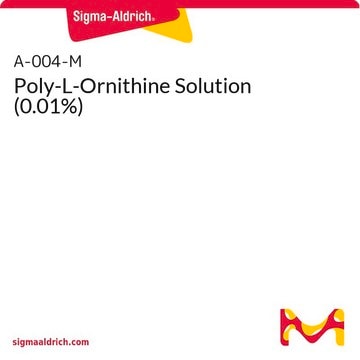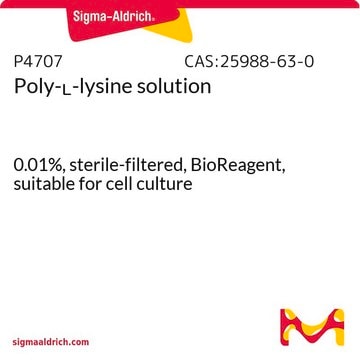This product is suitable for cell culture. Poly-L-ornithine hydrobromide is used for coating culture plates for cell culturing.
P3655
Poli-L-ornitina
suitable for cell culture, Mol wt 30,000-70,000
Sinonimo/i:
L-Ornithine homopolymer hydrobromide
Scegli un formato
Scegli un formato
About This Item
Prodotti consigliati
Nome del prodotto
Poli-L-ornitina, mol wt 30,000-70,000
Stato
powder
Livello qualitativo
PM
30,000-70,000
tecniche
cell culture | mammalian: suitable
Colore
white to off-white
Temperatura di conservazione
−20°C
Stringa SMILE
[Br-].NC(CCCN)C(=O)O.[H+]
InChI
1S/C5H12N2O2.BrH/c6-3-1-2-4(7)5(8)9;/h4H,1-3,6-7H2,(H,8,9);1H
GWRQMKDBBHFVIZ-UHFFFAOYSA-N
Cerchi prodotti simili? Visita Guida al confronto tra prodotti
Categorie correlate
Applicazioni
Azioni biochim/fisiol
Risultati analitici
Codice della classe di stoccaggio
11 - Combustible Solids
Classe di pericolosità dell'acqua (WGK)
WGK 3
Punto d’infiammabilità (°F)
Not applicable
Punto d’infiammabilità (°C)
Not applicable
Dispositivi di protezione individuale
Eyeshields, Gloves, type N95 (US)
Scegli una delle versioni più recenti:
Certificati d'analisi (COA)
Non trovi la versione di tuo interesse?
Se hai bisogno di una versione specifica, puoi cercare il certificato tramite il numero di lotto.
Possiedi già questo prodotto?
I documenti relativi ai prodotti acquistati recentemente sono disponibili nell’Archivio dei documenti.
I clienti hanno visto anche
progenitor cells from human cerebrospinal fluid in fetal
cystic myelomeningocele
Articoli
Discover L-ornithine, an important amino acid supplement, explore how L-ornithine is used in CHO and iPSC culture, and discover how poly-L-ornithine is used to enhance cell attachment.
Amino Acid Codon Wheel for fast RNA translation. Find which amino acid is translated from your RNA sequence quickly and easily.
Humankind has utilized protein materials throughout its existence, starting with the use of materials such as wool and silk for warmth and protection from the elements and continuing with the use of recombinant DNA techniques to synthesize proteins with unique and useful properties.
-
Can I use Poly-L-ornithine hydrobromide for coating plats in order to grow cells?
1 answer-
Helpful?
-
-
How is shipping temperature determined? And how is it related to the product storage temperature?
1 answer-
Products may be shipped at a different temperature than the recommended long-term storage temperature. If the product quality is sensitive to short-term exposure to conditions other than the recommended long-term storage, it will be shipped on wet or dry-ice. If the product quality is NOT affected by short-term exposure to conditions other than the recommended long-term storage, it will be shipped at ambient temperature. As shipping routes are configured for minimum transit times, shipping at ambient temperature helps control shipping costs for our customers. For more information, please refer to the Storage and Transport Conditions document: https://www.sigmaaldrich.com/deepweb/assets/sigmaaldrich/marketing/global/documents/316/622/storage-transport-conditions-mk.pdf
Helpful?
-
-
How can I determine the shelf life / expiration / retest date of this product?
1 answer-
If this product has an expiration or retest date, it will be shown on the Certificate of Analysis (COA, CofA). If there is no retest or expiration date listed on the product's COA, we do not have suitable stability data to determine a shelf life. For these products, the only date on the COA will be the release date; a retest, expiration, or use-by-date will not be displayed.
For all products, we recommend handling per defined conditions as printed in our product literature and website product descriptions. We recommend that products should be routinely inspected by customers to ensure they perform as expected.
For products without retest or expiration dates, our standard warranty of 1 year from the date of shipment is applicable.
For more information, please refer to the Product Dating Information document: https://www.sigmaaldrich.com/deepweb/assets/sigmaaldrich/marketing/global/documents/449/386/product-dating-information-mk.pdfHelpful?
-
-
For the product P3655-100MG Poly-L-ornithine hydrobromide, which solution I should use to dilute. what condition and how long I can storage after i dilute this compound.
1 answer-
This product is soluble in water up to 50 mg/mL. Solutions may be stored in aliquots at -20°C for at least 4 months. Avoid repeated freeze/thaw cycles. Please see the link below to review additional information available in the product datasheet:
https://www.sigmaaldrich.com/deepweb/assets/sigmaaldrich/product/documents/167/475/p3655pis.pdfHelpful?
-
Active Filters
Il team dei nostri ricercatori vanta grande esperienza in tutte le aree della ricerca quali Life Science, scienza dei materiali, sintesi chimica, cromatografia, discipline analitiche, ecc..
Contatta l'Assistenza Tecnica.









